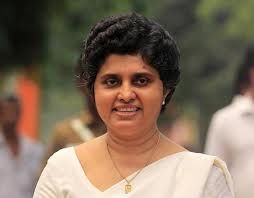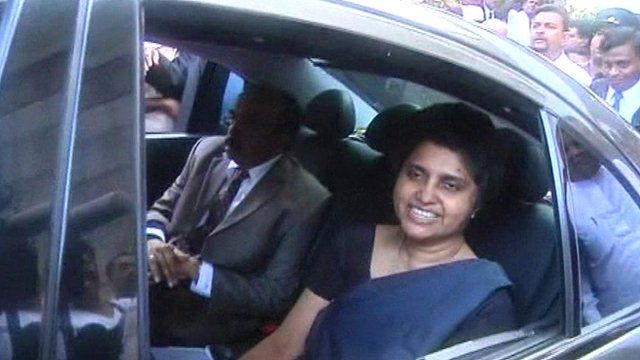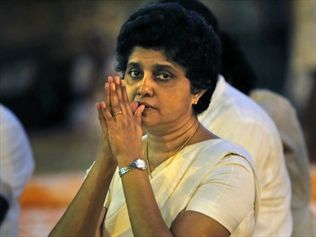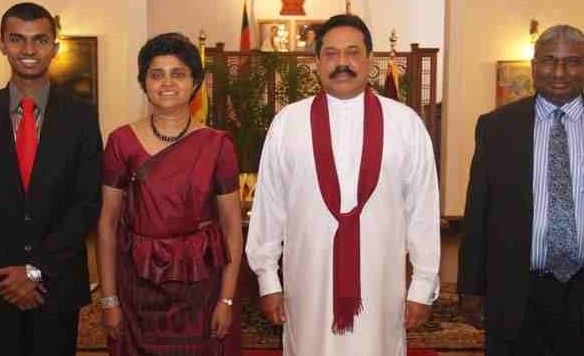
Publisher:
Bonnie King
CONTACT:
Newsroom@Salem-news.com
Advertising:
Adsales@Salem-news.com

~Truth~
~Justice~
~Peace~
TJP
Jan-20-2013 11:35

 TweetFollow @OregonNews
TweetFollow @OregonNews
End Of Constitutional Governance In Sri Lanka - Gadaffi Also Said 'The People Love Me'
Dr. Nihal Jayawickrama for Salem-News.comThe purported removal of a serving Chief Justice, and the purported appointment of a new Chief Justice, marks the end of constitutional governance in Sri Lanka.
 Sri Lanka’s Chief Justice Shirani Bandaranayake (C) walks out of the Supreme Court in Colombo on November 23, 2012 as lawyers see her off as she travels to the national parliament to face impeachment proceedings. -AFP Photo |
(COLOMBO, Sri Lanka Colombo Telegraph) - In Libya, at the height of the 2011 revolution, it was said that Colonel Gadaffi did not believe rebel claims of captured territory. And, as Tripoli was being encircled, Gadaffi famously exclaimed to a BBC interviewer that “the people love me”. 
The disinformation practised by the Libyan Government through the state controlled media was institutionalized to such an extent that even those in power, who concocted the lies, had begun to believe their own concoctions. When they saw the truth, it was too late for them. The rampaging mobs had ravaged their cities, and turned their palaces into rubble. I saw all of this both before and after.
In the past two months, we too, have experienced a virulent campaign of disinformation through the state media and other state organs in the effort to remove an inconvenient Chief Justice and replace her with one more amenable to the Government. It did not seem to matter that the exercise was both unlawful and unconstitutional, or that it would destroy the foundations of democratic governance. The Chief Justice had to go, and the load of gibberish gratuitously offered by state media and cabinet ministers was intended to lull the people into complacency. Even members of the Government had begun to believe the mumbo jumbo. One cabinet minister was so swayed by the Government’s own propaganda that he shouted out to the Supreme Court to “go to hell”.
The obsolete impeachment
“Impeach” was a word that was introduced into our political lexicon in mid-October, as the process to remove the Chief Justice began. It was a term that came with the weight of history. Soon, law professors and political columnists were delving into the history of “impeachment” across the globe, and arguing that no court could interfere with the process of impeachment. We were given an example from the United States, where one Robert Nixon, a district judge and convicted perjurer in an obscure region of Mississippi, had attempted unsuccessfully to have his impeachment by the Senate reviewed by the Supreme Court, on the ground that he should have been tried in the first instance, not by the House of Representatives, but by the Senate. But how relevant to us is the impeachment procedure prescribed under the 1787 Constitution of the United States of America? We are surely not aspiring to be the 51st state.
We were told that in the United Kingdom, judges are impeached by Parliament. But we were not told that in that country, where “impeachment” was once a process resorted to when a “peer” or “commoner” was accused of “high crimes and misdemeanours beyond the reach of the law”, it is now obsolete, its last use having been in 1802. In any event, the United Kingdom is governed, not under a written constitution, but by statute law and convention.
We have our own Constitution, and that Constitution does not provide for any form or kind of “impeachment”. The term “impeachment” does not appear even once in our Constitution. What article 107 states, with regard to a judge of a superior court, is that such judge “shall not be removed except by an order of the President made after an address of Parliament has been presented to the President for such removal on the ground of proved misbehaviour or incapacity”. There is no reference to “impeachment”. That term was obviously introduced into the public domain so that the baggage that it carries from the United States and elsewhere could be employed to challenge the constitutional right of the Judiciary to be subject to judicial review any decision that adversely affects an individual’s legal rights.
The fake supremacy
It was asserted, without any basis whatsoever, that Parliament is supreme. Apart from references to the Supreme Court, the only place in the Constitution where the word “supreme” appears is in the preamble where it is stated that the Constitution is the law of Sri Lanka. The 1978 Constitution, unlike its 1972 predecessor, is firmly entrenched on a separation of powers. Parliament exercises legislative power. The President exercises executive power. Courts, tribunals and other institutions established by the constitution or by law exercise judicial power. In fact, not only is one power not regarded as supreme in relation to the others, there is an inter-locking process, or a system of fine checks and balances, which is the essence of democratic governance in the civilized world.

For example, the President summons, prorogues and dissolves Parliament, but he cannot make law. It is Parliament alone that can make law (except in a state of emergency that is approved by Parliament). Parliament, however, cannot proceed to enact a law until the Supreme Court has examined and certified that the Bill for that law is in accordance with the Constitution. Neither the Speaker, nor a select committee, can perform that function.
The President alone may exercise executive power, but he is “responsible to Parliament” for the due exercise of his powers and duties, and it is Parliament that provides him the funds necessary to perform his legitimate functions. If he is faced with a question of law of public importance, he is required to refer it to the Supreme Court (and not to Parliament) for its opinion on that question. The President may be removed from office by resolution of Parliament for bribery, misconduct, corruption, abuse of power or intentional violation of the Constitution, but only if the Supreme Court, after due inquiry reports to Parliament that he is guilty of one of more of the allegations. The President may address Parliament, but he may not appear and be heard in the Supreme Court, except when that court is investigating his conduct on a reference by the Speaker. The President may pardon a person convicted by a Court, or remit or commute a sentence imposed by a Court, but he may not set aside or overrule an order or judgment of a Court.
The Judiciary alone may exercise judicial power, but Judges of the Supreme Court and of the Court of Appeal, though appointed by the President, may be removed by the President only on a resolution of Parliament, and only on the ground of “proved misbehaviour or incapacity”. The Supreme Court alone may interpret the Constitution, but Parliament may amend or repeal the Constitution. Parliament may summon a judge to appear before a select committee conducting an inquiry relevant to its legislative or oversight functions, while a judge may summon a Member of Parliament to appear before him as a witness, party to a proceeding, or an accused.
A delicate balance of power
The respective roles of Parliament and the Supreme Court are best exemplified in the Parliament (Powers and Privileges) Act. In respect of any alleged breach of privilege which cannot be punished with “admonition at the Bar of Parliament” or “removal from the precincts of Parliament” (the only two punishments that the law allows Parliament to impose on anyone), Parliament is required to refer to the Supreme Court every other alleged breach of privilege that warrants a penalty more severe than these. In fact, if a person summoned by a select committee to give evidence or to produce a document, disobeys that order and fails to appear or produce the document, the select committee has to refer that matter to the Supreme Court if it desires to punish that person.
The constitutional relationship between the three organs of government, this delicate balance of power, therefore, requires mutual respect. For one branch to tell the other “to go to hell”, or that its judgment is “not worth the paper on which it is written”, is to demonstrate an unfortunate lack of understanding of the processes of government, or an incredible arrogance based on ignorance. If it is neither of these, then, it is a classic example of disinformation designed to mislead the public. It also demonstrates a lack of institutional memory.
For example, when in 1958, Prime Minister S.W.R.D. Bandaranaike wanted to persuade a Judge to head a commission of inquiry, he visited Hulftsdorp on a Saturday morning and met the Judges in the Supreme Court Library; he did not summon them to his residence or to his office. In 1973, Chief Justice H.N.G. Fernando sought an appointment with the Prime Minister to discuss certain administrative difficulties that had arisen in the Criminal Justice Commission (1971 Insurgency) over which he was presiding. Mrs Bandaranaike considered it improper that the person who was presiding over a trial in which the accused were charged with attempting to overthrow her Government, should meet her at her residence at Temple Trees. She requested me to meet him, in my capacity as Permanent Secretary to the Ministry of Justice. Mrs Bandaranaike did not personally speak with any potential Chief Justice or Judge of a superior court. Instead, she left that task to the Minister or Secretary of Justice. Such was the scrupulous manner in which conventions that underpinned the separation of powers were understood and observed in the past.
Of course, there were conflicts from time to time. In 1973, when I attended, on invitation, a ceremonial sitting of the Supreme Court and, on the instructions of the Minister, sat next to him at the Bar Table, the response of Chief Justice Tennekoon was peremptory. I was asked to sit in the row behind, which I did. It was not that we had nowhere else to sit. I usually stood at the back of the crowded courtroom on such occasions. It was the Minister’s view that, by sitting at the Bar Table, we would convey the message to the Judiciary that the Legislature and the Executive, too, had roles to play in the administration of justice. As it turned out, the Judiciary carried the day!
Falsifying the past
The removal of the Chief Justice after a flawed “investigation” under standing order 78A, which the Supreme Court determined to be void ab initio, has been sought to be covered up by the assertion that several judges had been “impeached” in the past by employing this same standing order. This is factually incorrect, and is yet another attempt at disinformation.
 The one single occasion when a select committee was appointed under this hastily drawn up standing order was in 1984. An allegation of misbehaviour was made against Chief Justice Samarakone barely one month before he was due to retire from office. His counsel, Mr S. Nadesan QC, did not dispute the facts, but challenged the constitutionality of the standing order. He made submissions on 14 days over a period of two months. The select committee reported, after the Chief Justice had reached his mandatory age of retirement, that the charge of misbehaviour had not been established.
The one single occasion when a select committee was appointed under this hastily drawn up standing order was in 1984. An allegation of misbehaviour was made against Chief Justice Samarakone barely one month before he was due to retire from office. His counsel, Mr S. Nadesan QC, did not dispute the facts, but challenged the constitutionality of the standing order. He made submissions on 14 days over a period of two months. The select committee reported, after the Chief Justice had reached his mandatory age of retirement, that the charge of misbehaviour had not been established.
The two other select committees that were appointed to inquire into the conduct of judges were fact-finding exercises, at a time when standing order 78A was not in existence. The first was In 1983, to inquire into a complaint made to President Jayewardene by Mr K.C.E. de Alwis, a former Judge of the Court of Appeal and a Member of a Special Presidential Commission, against Justice Wimalaratne and Justice Colin Thome who, together with Chief Justice Samarakone, had issued a writ of prohibition restraining De Alwis from continuing to be a member of that Commission. The second was in April 1984, to inquire into and report on whether Chief Justice Samarakone had made a certain speech on a certain occasion.
When, in June 2001, the Opposition attempted to present a resolution seeking the removal of Chief Justice Sarath Silva, President Kumaratunge prorogued Parliament and aborted the process.
When, in 2004, the UNP Government was making arrangements to establish a tribunal consisting of three Commonwealth Judges to inquire into charges against the same Chief Justice, President Kumaratunge again aborted the process by dissolving Parliament.
Misinforming the present
The disinformation campaign also sought to make out that, even in other countries, Judges are “tried” by Parliament. Reference was made to the United States and Philippine Constitutions where the Senate is vested with the sole power to “impeach” a Judge. The Senate in each of these two countries is not even remotely comparable to our Parliament for the simple reason that it does not have among its members anyone who holds executive office. The Cabinet, in both these countries is drawn from outside the legislature.
 |
What the disinformation campaign cleverly attempted was to misrepresent the position in the United Kingdom. Under the Constitutional Reform Act of 2005, an appellate judge may be removed from office by the Lord Chief Justice and the Lord Chancellor if, after an investigation by an Investigating judge, they both agree to uphold a report that finds the complaint against the judge to be justified. In the case of the Lord Chief Justice of Northern Ireland, a resolution for his removal may be introduced only by the Lord Chancellor, and only after a three-member tribunal has reported that grounds exist for such removal. No provision yet exists for the investigation of an allegation of misbehaviour against the Lord Chief Justice of England and Wales (the Head of the Judiciary), or of the Judges of the Supreme Court of the United Kingdom (which replaced the House of Lords). However, it has been suggested that should the need ever arise to do so, the procedure prescribed for Northern Ireland will be followed. Judicial ethics are so widely respected in that country, the democratic fabric is so secure, parliamentary and judicial proceedings are so transparent, and constitutional conventions so strong, that it is almost inconceivable that an occasion would arise for the removal of the Lord Chief Justice of that country.
The disinformation campaign also hides the fact that in practically every Commonwealth country, the Latimer House Guidelines have been incorporated into domestic law. A judge may be removed from office, whether on a parliamentary resolution or otherwise, only after an independent tribunal has found that judge guilty of misbehaviour or incapacity. From Australia to Uganda, through Belize, Botswana, Canada, Cyprus, Ghana, Guyana, India, Kenya, Malaysia, Singapore and South Africa (to name only a cross section of Commonwealth countries selected at random), this is the consistent constitutional practice.
Sri Lanka stands outside the fold, an outlaw as it were, claiming the right to bulldoze its way, with slogan-shouting, stick-waving, screaming mobs, protected by armed police and the military, padlocked gates, water cannons, and fireworks – all this and more to remove from office the lawful Chief Justice of the Republic, the first woman, the first academic, the first product of a non-urban school who, with her quiet dignity, grace and determination, surpassed herself as she faced what must have been the greatest challenge of her life.
End of constitutional governance
The purported removal of a serving Chief Justice, and the purported appointment of a new Chief Justice, marks the end of constitutional governance in Sri Lanka. These were the final acts in a series of bizarre events orchestrated by the Government in the past six weeks. These events were accompanied by an unprecedented campaign of disinformation, at a level and of a kind we have not been subjected to in recent years. Parliament is no longer a legislative body that can hold the government accountable. With two-third of its members serving as salaried officers of the Executive, it has been transformed into a mere legislative arm of the Executive. With the judgment of its highest court incapable of being enforced, and the head of that court pushed out of office by brute force, the once proud, independent and internationally acclaimed Judiciary of our country has been dealt a body blow of unimaginable magnitude. We have begun an era of unbridled, authoritarian presidential rule.
Dr. Nihal Jayawickrama was the former Permanent Secretary to the Ministry of Justice (1970–1977), Professor of Law at University of Hong Kong (1984-1997), Ariel F Sallows Professor of Human Rights at the University of Saskatchewan, Canada (1992-1993), and Executive Director of Transparency International (1997-2000) He is now an independent legal consultant, and has been the Coordinator of the UN-sponsored Judicial Integrity Group since 2000.
Â
 |
 |
 |
Articles for January 19, 2013 | Articles for January 20, 2013 | Articles for January 21, 2013
Quick Links
DINING
Willamette UniversityGoudy Commons Cafe
Dine on the Queen
Willamette Queen Sternwheeler
MUST SEE SALEM
Oregon Capitol ToursCapitol History Gateway
Willamette River Ride
Willamette Queen Sternwheeler
Historic Home Tours:
Deepwood Museum
The Bush House
Gaiety Hollow Garden
AUCTIONS - APPRAISALS
Auction Masters & AppraisalsCONSTRUCTION SERVICES
Roofing and ContractingSheridan, Ore.
ONLINE SHOPPING
Special Occasion DressesAdvertise with Salem-News
Contact:AdSales@Salem-News.com


googlec507860f6901db00.html
Salem-News.com:

Terms of Service | Privacy Policy
All comments and messages are approved by people and self promotional links or unacceptable comments are denied.
[Return to Top]
©2025 Salem-News.com. All opinions expressed in this article are those of the author and do not necessarily reflect those of Salem-News.com.